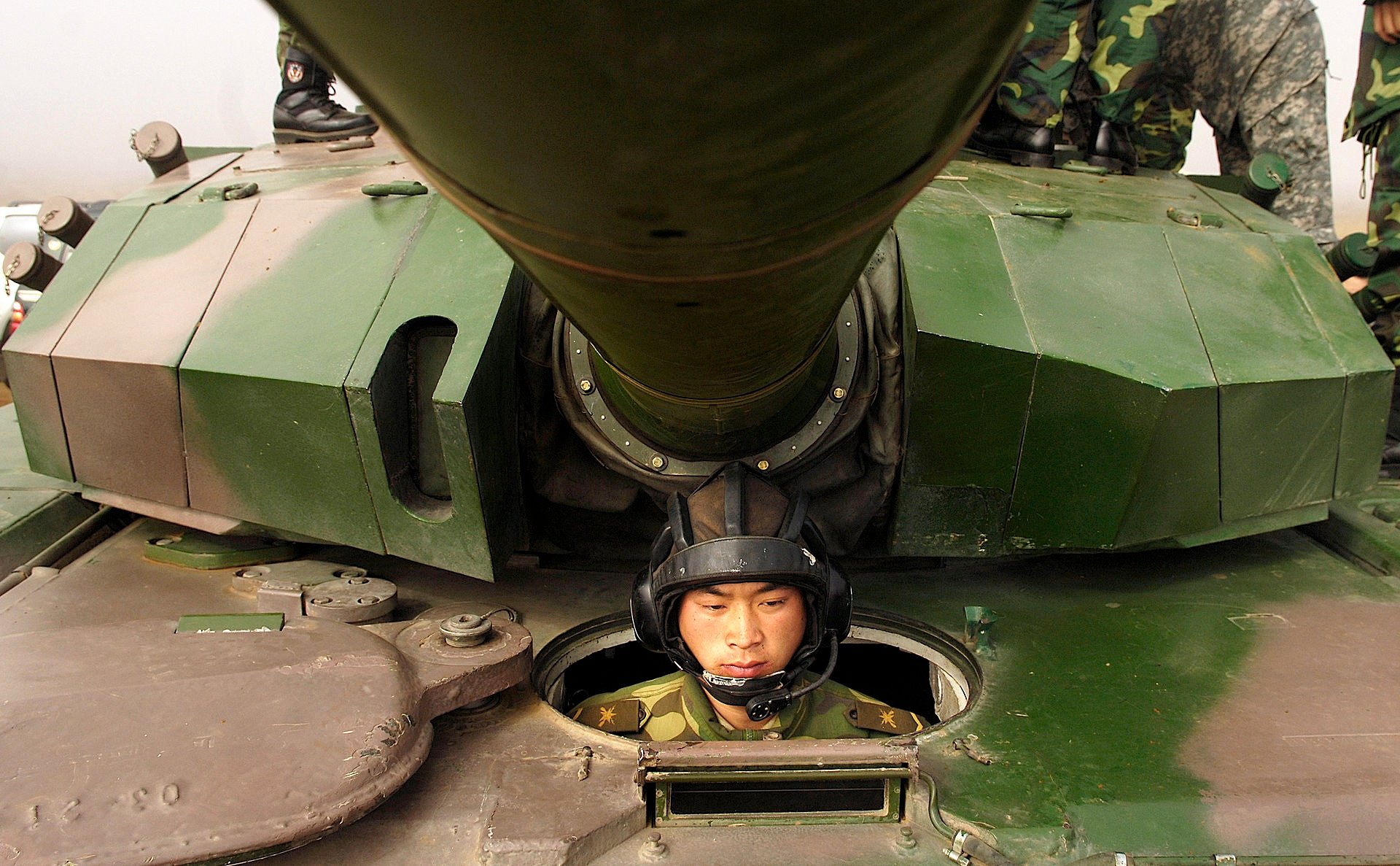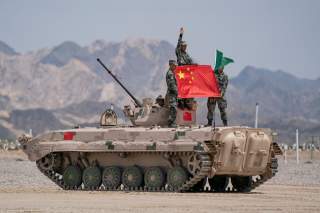China's Type 99 Tank Is Here (And It Can Wage War Against Anyone)
China's military modernization has been a long time coming.
Key point: China has finally fielded a first-class main battle tank.
China has a lot of tanks. Like, eight to nine thousand of them.
Who else would bother to maintain such a ridiculous number?
The United States. And Russia. (Note that such counts include vehicles in storage and reserve. The numbers for tanks in operational units are lower in every case).
However, the majority of Beijing’s tanks are old designs, particularly Type 59 and 69 tanks more or less directly copied from the 50s-era Soviet T-54 tank. Such is their profligacy that I once had the pleasure of bumping into one in a children’s playground in Tianjin serving the needs of the (young) people.
However, China’s top of the line tank, the Type 99, has commanded healthy respect from international observers, even though it has never been exported, nor used in combat. The reason is simple: the reported performance parameters are equal to many top Western designs, and the Type 99 also packs a few unique tricks of its own.
Today we’ll look at how the Type 99 stacks up to two important contemporaries, the American M1A2 Abrams and the Russian T-90A tank.
Before we get our hands greasy with the technical details, we should consider: does China even need tanks?
It’s a reasonable question to ask. China’s major military efforts have been directed towards the Pacific.
Some might ask, how likely are the U.S. Army’s M1 Abrams tanks ever to clash with the Type 99?
To which one should consider: can either vehicle swim across the Pacific Ocean and exchange shots over Scarborough Shoal?
Kidding aside, it seems a pretty unlikely except in amphibious invasions scenarios fit for Operation Flashpoint computer games. On the other hand, Taiwan has expressed interest in purchasing Abrams tanks, and Australia operates 60 as well, so never say never.
However, the question is more relevant when we consider the Russian T-90. Moscow currently maintains good relations with Beijing, with which it shares a border, but the two powers are not close allies, having nearly come to war during the late 1960s.
Most importantly, Russia is selling its weapons to India and Vietnam—including systems which are quite clearly earmarked to oppose the Chinese military, such as the Brahmos cruise missile, and, well…over 1,000 T-90 tanks, many of which are deployed along its Himalayan border.
China fought a war with India in 1962 over that border, and another with Vietnam in 1979 to punish the nation for opposing the Beijing-backed Khmer Rouge regime in Cambodia. (Vietnam would like to order T-90s as well.)
Today, the Chinese military persists in seeing India—a potential future superpower—as a threat, and has extensively militarized their shared border and built roads allowing heavy military vehicles to pass through the steep mountains. China is also allied with Pakistan, which has repeatedly warred with India, and occasionally transfers military technology to it.
Recommended: Imagine a U.S. Air Force That Never Built the B-52 Bomber
Recommended: Russia's Next Big Military Sale - To Mexico?
Recommended: Would China Really Invade Taiwan?
Lastly, one should consider the scenario of a potential civil war or government collapse in North Korea. What Beijing’s policy would actually be in such an event is the trillion dollar question, but one scenario would involve Chinese ground forces intervening to restore order in North Korea—leading to potential clashes with Korean troops.
So, even though an actual armed conflict would be unnecessary and vastly counterproductive for everyone involved—like most wars!—there are some contexts in which tank combat could occur on China’s borders, particularly verses Russian-made tanks.
Enough politics, onto the lumbering death machines!
First, to introduce the contenders…

The Abrams, of course, is the classic American design which devastated Soviet-made Iraqi armor in the 1991 Gulf War without losing a single tank to enemy fire. The Abrams isn’t exactly new, but the Army has continuously tweaked the ammunition, armor package, and sensors to keep it up to date.
The T-90 is Russia’s first post-Cold War tank. Though not quite a peer of the Abrams, it still boasts significant improvements in accuracy and protection, particularly in models equipped with later-generation explosive reactive armor. While Russia is introducing its revolutionary new T-14 tank, for now its 550 T-90As remain its frontline armored vehicle.
Moscow has developed the more advanced T-90AM but did not place it into full production. However, 354 of the similar T-90MS export variant have been sold to India for deployment on its border with China. In total, India has over 1200 T-90s, while Algeria eventually intends to operate over 800.
China’s Type-99 combines a hull that closely resembles an elongated T-72 with a Western-style turret inspired in part by the German Leopard 2. First appearing as the Type 98 prototype tank in a National Day parade in a 1999, the vehicle was re-designated the Type 99 and entered service in 2001. At 57 tons, it comes in between the 70-ton Abrams and the 48-ton T-90 in terms of weight. Several upgrades, including the new Type 99A2 variant, boast advanced new technologies. Beijing fields nearly 500 Type 99s in sixteen armored battalions, and has produced 124 of the newer 99As so far. The type is not offered for export, though some of its technology is used in China’s VT4 export tank.
Firepower:
The Type 99 and the T-90 rely on a 125 millimeter cannons using carousel autoloaders descended from Soviet-era designs. This weapon proved underpowered verses Abrams and Challenger tanks in the Gulf War, but new improved tungsten ammunition leaves it capable of piercing the frontal armor of an Abrams at shorter combat ranges.
The new Type 99A2 comes with a longer barrel main gun, which in theory should impart higher muzzle velocity to sabot shells and improve their armor penetration and accuracy. It also boasts fancy new stabilizer technology.
Reportedly, China intends to eventually install a larger 140 millimeter gun on the Type 99, but early tests have cracked up the weapon. This, incidentally, mirrors Russia’s plans to up-gun its new T-14 Armata tank to a similar caliber weapon.
The Abram’s Rheinmetal 120 millimeter gun, equipped with politically-controversial M829 depleted-uranium rounds, can penetrate around 15-25% more armor. The U.S. now produces new generations of M829 rounds capable of piercing the advanced Kontakt and Relikt reactive armor systems developed by Russia (more on those below).
China has developed its own depleted uranium ammunition for its 125 millimeter gun, which it claims can penetrate the M1 up to ranges of 1.4 kilometers.
The Abrams uses a fourth crewmember to load the gun, which American tankers argue is more reliable, offers a higher rate of fire, and gives the tank a spare hand if one of the other crew members is incapacitated. However, the space needed to accommodate a fourth crew member makes the M1 larger and heavier.
The Type 99 and T-90 both can fire anti-tank missiles from the gun tube, while the Abrams cannot. (The Type 99 uses AT-11 Refleks missiles licensed from Russia). This could theoretically be useful for combat at very long ranges, or against low-flying helicopters. However, tank-launched missiles have existed for fifty years without seeing much use.
Effective sensors for spotting and aiming are arguably as decisive in tank engagements as firepower. Russia has made some strides in tank sights and thermal imagers in recent years, though the general sentiment is that Western sights and sensors remain superior. The T-90A does not carry Russia’s best hardware (some have been upgraded with French Catherine thermal sights), while the T-90MS has an improved Kalina targeting system.
China is known for its excellent electronics, and the Type 99A2 supposedly carries a new infrared tracking system that enables it hunt enemy tanks efficiently and is believed to be superior to the systems on the T-90A.
Protection:
The Type 99 benefits both from composite armor, and Explosive Reactive Armor (ERA), bricks of explosives onto the tank that prematurely detonate incoming shells. The new Type 99A2 variant uses a multi-layered system thought to be similar to the Relikt ERA developed by Russia, which uses a radar to detonate the ERA before hostile shells impact. It is intended to defeat tandem-charge missiles capable of overcoming older-generation ERA.
The T-90A uses the older Kontakt-5 ERA, while the new T-90MS tanks serving in India sport the Relikt system. Though most effective against anti-tank missiles, both systems also diminish the penetrating power of tank shells.
The Type 99 also comes with a Laser Warning Receiver which warns the tank commander if his vehicle is being painted with hostile targeting lasers, affording the driver a chance to back away out of danger. Given all the videos from Syria and Yemen of tanks sitting obliviously as anti-tank missiles meander towards them (often taking 20 seconds or more to impact), this could significantly improve survivability.
The Type 99 also is believed to come with its own unique high-powered ‘dazzler’ laser designed to jam laser- and infrared-guided missiles, damage enemy sights, and blind the eyes of hostile gunners, possibly with a permanent effect. Fortunately, high-power tank-mounted dazzlers have never been used in combat before, so we have no idea how well they would work.

